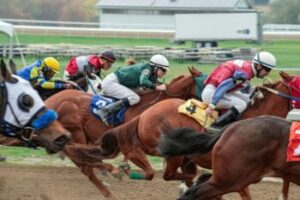This May 17, 2025, the Preakness Stakes will draw horse racing fans worldwide for the 150th race in its storied history. Every year, the event brings together powerful horses, passionate fans, and a unique atmosphere that’s hard to beat. But beyond the high-speed action, there’s a rich history behind the race that makes it even more special.
Let’s look closer at how the Preakness became a staple of the Triple Crown and what makes it stand out in horse racing.

What Makes the Preakness Stakes the Iconic Race It Is?
he Preakness Stakes is the second-oldest race in the Triple Crown Series, introduced two years before the Kentucky Derby’s first run. At first, the race was a mile and a half long (2.41 km) and was named after a colt called Preakness. He came from Preakness Stud, a farm owned by Milton Holbrook Sanford in Preakness, New Jersey. Preakness won the Dinner Party Stakes on the day Pimlico Race Course opened on October 25, 1870.
After jockey Bully Hayward won the Dinner Party Stakes, he untied a silk bag filled with gold coins. This bag was hung from a wire across the track near the judge’s stand. This is how the “wire” at the finish line and the awarding of prize money, called the “purse,” began. However, “purse” was already used for prize money for over a hundred years before this.
The first-ever Preakness Stakes took place on May 27, 1873, with seven horses racing. The winner was a three-year-old horse named Survivor, owned by John Chamberlain. Survivor won the race by 10 lengths and took home $2,050 in prize money. This 10-length victory was the largest margin of victory until 2004 when Smart Jones set a new record by winning by 11 ½ lengths.
Besides its storied past, the Preakness Stakes continues to capture the public’s attention for the excitement it brings to racing fans. Many bettors engage with the race on reliable platforms like FanDuel, as it is a major part of the American horse racing calendar, celebrating both tradition and modern thrill, uniting fans and bettors alike each year.
The Preakness and Its Unique Place in the Triple Crown
The Preakness Stakes is the second race in the Triple Crown of horse racing. It is 9 1/2 furlongs, or 13/16 miles long, a bit shorter than the Kentucky Derby, which is 10 furlongs, or 1 1/4 miles. After the Preakness, the final race is the Belmont Stakes, 12 furlongs, or 11/2 miles long.
Since 1932, the Triple Crown races have been held in this order: Kentucky Derby first, followed by the Preakness, and then the Belmont. However, before 1932, the Preakness was run before the Kentucky Derby 11 times. In 1917 and 1922, both races were held on the same day.
Today, the Preakness takes place on the third Saturday in May. It’s held three weeks before the Belmont Stakes and two weeks after the Kentucky Derby. It race can happen between May 15 and May 21, but in 2020, it was held in early October because of the COVID-19 pandemic.
The Top All-Time Winning Trainers and Jockeys
The Preakness Stakes is an equestrian race filled with expert and successful jockeys and trainers. Regarding jockeys, one of the most successful riders to mention is Jose Ortiz. He will be atop Clever Again in the Run for the Black-Eyed Susans this year.
Ortiz earned over $497 million in career earnings. He also has three Kentucky Derbys, two Belmonts, and a Preakness, making him one of the sport’s best riders. Other jockeys that deserve special mention in the Preakness are Irad Ortiz Jr., Jose Ortiz, and Flavien Prat.
If we talk about the most promising pairings between jockey and trainer, experts and fans would not hesitate to mention the Baffert-Prat duo behind Goal Oriented and the Pletcher-Ortiz Jr. team with River Thames.
Steve Asmussen is now the top trainer in North American horse racing. However, he hasn’t won the Preakness Stakes since 2009. Many fans are wondering: Can 2022 Preakness winner Jose Ortiz help Asmussen break his dry spell and win the Preakness again with Clever Again?
What’s Next for the Preakness Stakes?
The Preakness Stakes is stealing the headlines with the confirmed horses joining the field. But beyond the thoroughbreds, the Pimlico Race Course’s demolition and reconstruction is also earning the attention of racing fans.
The design concepts for the new Pimlico Race Course were revealed on May 7. Demolition will start in June, and a $400 million renovation by state bonds will follow.
For the Preakness Stakes next year, the race will be relocated to Laurel Park, which is about 20 miles south of Pimlico. The new Pimlico facility is expected to open in 2027, and the Preakness Stakes will return to Baltimore by then. Once Pimlico reopens, Laurel Park will close for its own redevelopment.
The multi-year project will include a new hotel, event space, and a state-of-the-art Thoroughbred training center at Shamrock Farm in Woodbine, Maryland. The design takes inspiration from Baltimore landmarks like the Rawlings Conservatory and the original Pimlico Clubhouse.
The state will invest at least $110 million in the new training facility, featuring 328 acres for over 800 horses, housing for workers, and a training track matching Pimlico’s dimensions.
“Today we take another step toward a new, reimagined Pimlico,” said Maryland Governor Wes Moore (Citybiz, May 12, 2025). “Together, we will continue to drive economic growth in Park Heights, throughout Baltimore, and across the entire state.”
Reflecting on the Preakness’ Past
While anticipation builds for the Preakness’ 150th race, reflecting on its history reminds us of the traditions it represents. This race has seen many changes from its early days to now, but its core has always been about passion, competition, and a shared love for the sport. As fans, being aware of the past helps us embrace all the changes while still honoring the race’s long-standing traditions.